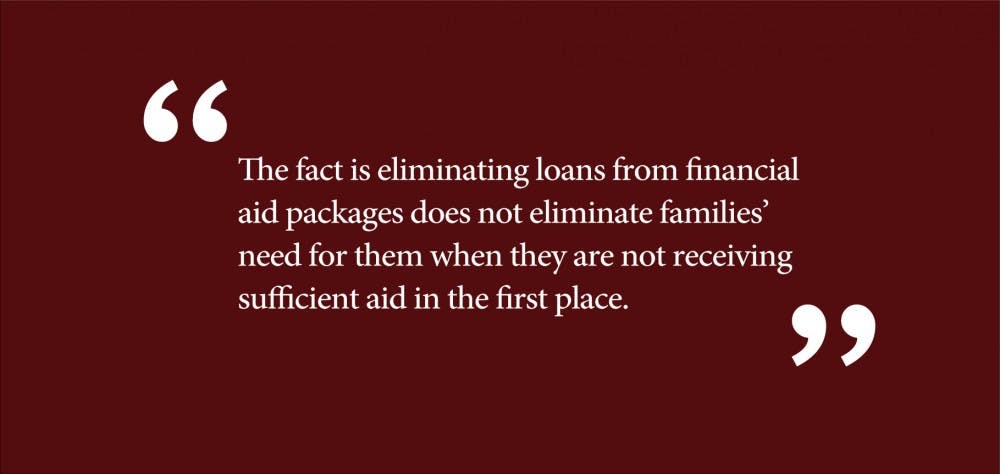Fall semester at Brown has invited the usual wave of prospective students crowding the entrance of the Stephen Robert ‘62 Campus Center before they embark on one of the highly recommended campus tours. The members who hope to join the Class of 2023 appear to follow the typical pattern, but there is something distinct about this round of applicants. In a recent Brown University Community Council meeting, Dean of Admission Logan Powell proudly announced that the amount of early decision applicants increased by 20 percent from 3,501 applicants for the class of 2022 to 4,169 applicants for the class of 2023. Furthermore, the number of early decision applicants who reported an interest in receiving financial aid grew by 11 percent in the last year.
Powell pins the growth in ED applicants largely to the implementation of the Brown Promise, an initiative that involves replacing loans with University scholarship funds in all undergraduate financial aid packages. This is another step in a process toward making a Brown education accessible to all families regardless of income. In 2008, Brown first replaced loans with University scholarships solely for families with a total parental income of less than $100,000, according to the University’s financial aid website. This opened Brown’s doors to many more low-income families, but did not reach those moderate-income families who did not qualify for the more generous financial aid that low-income families receive. The difference with the Brown Promise is the absence of the $100,000 threshold, which granted all undergraduate students loan-free financial aid packages beginning this year.
I remember reading the email announcing the Brown Promise and immediately texting my parents the news. I wanted them to join me in a refreshing wave of optimism after navigating the twists and turns of applying for financial aid as a middle-class family. My parents earn too much money to qualify for substantial financial aid, yet they do not earn enough to be able to comfortably afford my education. Surely enough, when I received my financial aid package for the 2018-19 school year, I found that what used to be loans were replaced by additional University scholarship funds. This change should have ushered in a new chapter of my college experience in which I would no longer be weighed down by the financial burden of my education. However, the relief only lasted briefly.
The fact is that eliminating loans from financial aid packages does not eliminate families’ need for them when they are not receiving sufficient aid in the first place. My experience has revealed a key inadequacy of the Brown Promise in making a significant change in my life and perhaps the lives of other moderate-income students. It should be made clear that the Brown Promise does not increase financial aid, but instead replaces loans with scholarships. Therefore, if the amount of financial aid that families receive remains insufficient, they will still have to request loans from Brown or seek private loans elsewhere, which often carry greater consequences such as higher interest rates and the lack of federal interest subsidies. Indeed, while replacing portions of tuition covered by loans with scholarships may decrease student debt after college, the Brown Promise makes little difference in the short-term affordability of an education. If the actual amount of financial aid does not increase, families will still struggle to afford the cost of attendance. As long as moderate-income families are unable to afford the family contribution that their existing financial aid packages demand, Brown will remain inaccessible to many students who wish to attend.
My hope is that the University does not assume that the spike in ED applicants signals that the problem has been solved. In order to expand financial accessibility to moderate-income students, Brown should adjust the manner in which financial aid eligibility is calculated so that the family contribution more adequately reflects families’ actual abilities to pay without having to request loans from the University or elsewhere. Financial anxiety makes it very difficult for students receiving aid to fully embrace all of the opportunities and connections that Brown offers. On multiple occasions, I have felt that my enrollment here hangs in the balance due to financial struggles. Moderate-income students work just as hard and are just as deserving of attending Brown as those who can afford full tuition, and it is cruel that the only obstacles standing in between them and a fulfilling education are financial circumstances beyond their control. Eliminating loans from financial aid packages is a step in the right direction toward resolving this issue, but increasing financial aid would go much further.
Jordan Allums ’21 can be reached at jordan_allums@brown.edu. Please send responses to this opinion to letters@browndailyherald.com and other op-eds to opinions@browndailyherald.com.



